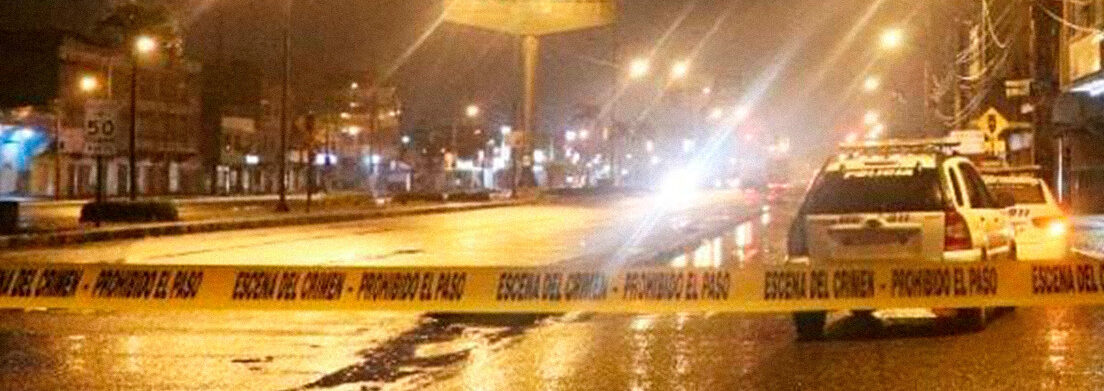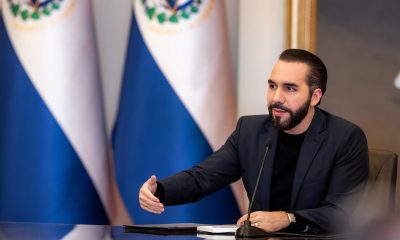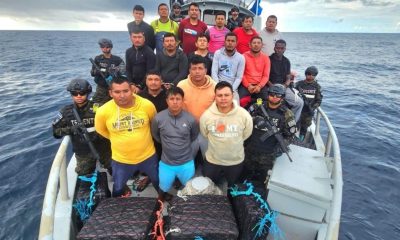International
Grisly killings stoke cartel fears in Ecuador

AFP
The bodies of two men hung from a pedestrian bridge in southwestern Ecuador stunned the country Monday and raised the spectre of Mexican cartels there.
The victims were killed, tied up and suspended by the same rope on a pedestrian bridge in Duran, a city near Guayaquil, Ecuador’s biggest city, police said.
As the South American country faces an upsurge in violence linked to drug trafficking, the national press has stressed the singularity of the incident.
The two men had been missing since February 11, according to police, and an investigation was underway into their abduction.
The crime could be linked to “the capture of seven tons of cocaine” Sunday in the port of Guayaquil, the commander of the zone, Marcelo Cortez, said.
One of the victims has already been identified by the media as Carlos Alberto Escobar. He was 34 years old and was recognized by a tattoo.
In the past four months, five decapitated people have been found in Duran and Guayaquil, the region hardest hit by the violence which authorities link to conflicts between local groups of drug traffickers with ties to powerful Mexican cartels.
These rivalries are at the root of the deadly violence that has plagued Ecuadoran prisons for months, in particular the huge prison complex in Guayaquil, where around 320 inmates were killed in a riot last year.
Ecuador was for years a transit point for cocaine produced in Colombia and Peru — bordering countries and the world’s leading suppliers of this drug — but the intelligence services believe that this lucrative enterprise is now deeply rooted within the country itself.
“The country is under attack by an international mafia of drug cartels,” a presidential official said in November.
International
Police investigate deaths of Rob Reiner and wife as apparent homicide

The Los Angeles Police Department (LAPD) is investigating the deaths of Hollywood actor and filmmaker Rob Reinerand his wife as an “apparent homicide,” amid a wave of tributes to the director of classics such as When Harry Met Sally.
According to U.S. media reports on Sunday, Rob Reiner and Michele Singer Reiner were found dead at their Los Angeles mansion with what appeared to be stab wounds.
Several political figures shared messages of condolence following the reported deaths of the director of A Few Good Menand his wife.
While the LAPD did not officially confirm the identities of the victims, it stated that homicide detectives were dispatched to the Reiner residence.
“At this time, no additional details are available and the investigation into an apparent homicide is ongoing,” the Los Angeles Police Department said in a statement posted on social media.
LAPD Deputy Chief Alan Hamilton told reporters that no arrests have been made and that no individuals are currently being questioned as suspects.
“I’m not going to confirm whether anyone is being questioned at this moment or not. We are going to try to speak with as many family members as we can,” Hamilton said.
CNN reported that a family spokesperson confirmed the deaths of Reiner and his wife.
California Governor Gavin Newsom, former U.S. President Barack Obama, and former Vice President Kamala Harrisissued statements expressing their condolences.
International
U.S. and Mexico Reach Deal to Address Water Deficit Under 1944 Treaty

The United States and Mexico have reached an agreement to comply with current water obligations affecting U.S. farmers and ranchers and for Mexico to cover its water deficit to Texas under the 1944 Water Treaty, the U.S. Department of Agriculture said in a statement.
The department уточified that the agreement applies to both the current cycle and the water deficit from the previous cycle.
On Monday, U.S. President Donald Trump accused Mexico of failing to comply with the water-sharing treaty between the two countries, which requires the United States to deliver 1.85 billion cubic meters of water from the Colorado River, while Mexico must supply 432 million cubic meters from the Rio Grande.
Mexico is behind on its commitments. According to Washington, the country has accumulated a deficit of more than one billion cubic meters of water over the past five years.
“This violation is severely harming our beautiful crops and our livestock in Texas,” Trump wrote on Monday.
The Department of Agriculture said on Friday that Mexico had agreed to supply 250 million cubic meters of water starting next week and to work toward closing the shortfall.
Agriculture Secretary Brooke Rollins, quoted in the statement, said Mexico delivered more water in a single year than it had over the previous four years combined.
Trump has said that if Mexico continues to fall short of its obligations, the United States reserves the right to impose 5% tariffs on imported Mexican products.
Mexico’s Deputy Foreign Minister for North America, Roberto Velasco, said that a severe drought in 2022 and 2023prevented the country from meeting its commitments.
International
Several people shot in attack on Brown University campus

Several people were shot on Saturday in an attack on the campus of Brown University, in the northeastern United States, local police reported.
“Shelter in place and avoid the area until further notice,” the Providence Police Department urged in a post on X. Brown University is located in Providence, the capital of the state of Rhode Island.
U.S. President Donald Trump said on his social media platform Truth Social that he had been briefed on the situation and that the FBI was on the scene.
At 5:52 p.m. local time (11:52 p.m. GMT), Brown University said the situation was still “ongoing” and instructed students to remain sheltered until further notice.
After initially stating that the suspect had been taken into custody, Trump later posted a second message clarifying that local police had walked back that information. “The suspect has NOT been apprehended,” the U.S. president said.
-

 Central America5 days ago
Central America5 days agoHonduras election crisis deepens as CNE president denounces intimidation attempts
-

 International5 days ago
International5 days agoCuba battles out-of-control dengue and chikungunya epidemic as death toll rises to 44
-

 International5 days ago
International5 days agoColombia says it would not reject Maduro asylum request as regional tensions escalate
-

 International1 day ago
International1 day agoPolice investigate deaths of Rob Reiner and wife as apparent homicide
-

 Central America2 days ago
Central America2 days agoPanama seizes over three tons of drugs hidden in Caribbean port container
-

 International3 days ago
International3 days agoSeveral people shot in attack on Brown University campus
-

 Central America1 day ago
Central America1 day agoOAS urges swift recount in Honduras as election results remain uncertain
-

 International5 days ago
International5 days agoEcuador on track for record violence as homicides hit highest level in Latin America again
-

 International3 days ago
International3 days agoU.S. and Mexico Reach Deal to Address Water Deficit Under 1944 Treaty
-

 Central America5 hours ago
Central America5 hours agoBukele says AI partnership with xAI will transform public education in El Salvador
-

 Central America5 hours ago
Central America5 hours agoEl Salvador ranks among top countries in the Americas in fight against organized crime


























